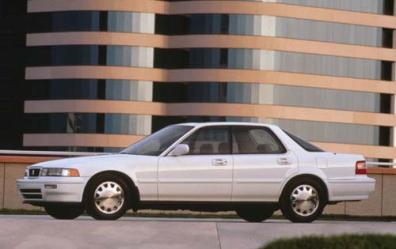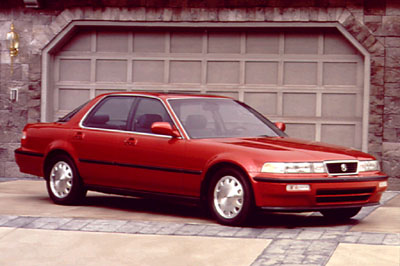 The Honda Vigor is Acura's mid-size sedan sold in Japan and the United States from 1981 to 1995, and was replaced by the Acura TL/Honda Saber. The Vigor started out in Japan only in the early 1980s as an upper trim level Accord. With later generations the Vigor moved upmarket and received a shared platform with the luxury oriented Honda Inspire: its engine now sat longitudinally as in the second generation Acura Legend. In Japan during the early 1990s, there were five sedans between the Civic and the Legend: the Honda Accord, Honda Ascot and Honda Integra with 4-cylinder engines mounted transversely, and the Vigor and Inspire with 5-cylinder engines mounted longitudinally. The Vigor was sold at Honda Verno dealerships in Japan, and the Honda Inspire was sold at Honda Clio dealerships.
The Honda Vigor is Acura's mid-size sedan sold in Japan and the United States from 1981 to 1995, and was replaced by the Acura TL/Honda Saber. The Vigor started out in Japan only in the early 1980s as an upper trim level Accord. With later generations the Vigor moved upmarket and received a shared platform with the luxury oriented Honda Inspire: its engine now sat longitudinally as in the second generation Acura Legend. In Japan during the early 1990s, there were five sedans between the Civic and the Legend: the Honda Accord, Honda Ascot and Honda Integra with 4-cylinder engines mounted transversely, and the Vigor and Inspire with 5-cylinder engines mounted longitudinally. The Vigor was sold at Honda Verno dealerships in Japan, and the Honda Inspire was sold at Honda Clio dealerships. Beginning September 25, 1981, Honda produced a variant of the Honda Accord badged as the Honda Vigor for Japan only. The first generation Vigor was a higher grade 4-door sedan and 3-door hatchback, with the 1.8 L engine as the only engine available. The Vigor was a sportier, faster, "vigorous" Accord with a higher level of equipment over the more sedate Accord. The Vigor competed with the Toyota Chaser and the Nissan Laurel in Japan. This engine debuted the SOHC 3 valve per cylinder mated to a 5 speed manual or 4 speed automatic transmission with a lock up torque converter. Items that were optional on the Accord, such as cruise control, power windows, and power steering were standard on the Vigor. A trip computer that displayed mileage, driving time, and fuel economy was also standard on the Vigor.
Beginning September 25, 1981, Honda produced a variant of the Honda Accord badged as the Honda Vigor for Japan only. The first generation Vigor was a higher grade 4-door sedan and 3-door hatchback, with the 1.8 L engine as the only engine available. The Vigor was a sportier, faster, "vigorous" Accord with a higher level of equipment over the more sedate Accord. The Vigor competed with the Toyota Chaser and the Nissan Laurel in Japan. This engine debuted the SOHC 3 valve per cylinder mated to a 5 speed manual or 4 speed automatic transmission with a lock up torque converter. Items that were optional on the Accord, such as cruise control, power windows, and power steering were standard on the Vigor. A trip computer that displayed mileage, driving time, and fuel economy was also standard on the Vigor. June 4, 1985 saw the introduction of the redesigned Vigor as a 4-door sedan only. As before, the Vigor was an uplevel Accord. The 1.8 L B18A engine was now offered with dual carburetors and a larger 2.0 L B20A engine was offered Honda's PGM-FI, with the 1.8 L A18A engine as the basic offering. The Vigor had minor cosmetic differences from the Accord, using a different front grille and rear tail lights, as well as a higher specification. May 1987 saw the introduction of the 2.0 Si Exclusive, adding electric retractable side view mirrors as standard. A automatic shift-lock system was added September 1988 on the "MXL Super Stage" trim level.
June 4, 1985 saw the introduction of the redesigned Vigor as a 4-door sedan only. As before, the Vigor was an uplevel Accord. The 1.8 L B18A engine was now offered with dual carburetors and a larger 2.0 L B20A engine was offered Honda's PGM-FI, with the 1.8 L A18A engine as the basic offering. The Vigor had minor cosmetic differences from the Accord, using a different front grille and rear tail lights, as well as a higher specification. May 1987 saw the introduction of the 2.0 Si Exclusive, adding electric retractable side view mirrors as standard. A automatic shift-lock system was added September 1988 on the "MXL Super Stage" trim level. At the launch of the fourth generation Accord, the Vigor was no longer based on the Accord chassis. The third generation Vigor, sold in Japan at Honda Verno dealerships, was shared with the all new Honda Inspire and the new second generation Honda Legend, sold at Honda Clio dealerships. The Vigor was sold in the United States and was badged as the first generation Acura Vigor in 1992. The Honda Inspire was not yet introduced to the USA until the next generation was introduced in 1995, and sold as the Acura 3.2 TL, with the Vigor sold as the Acura 2.5 TL. In Japan, the Vigor competed against the Toyota Chaser.
At the launch of the fourth generation Accord, the Vigor was no longer based on the Accord chassis. The third generation Vigor, sold in Japan at Honda Verno dealerships, was shared with the all new Honda Inspire and the new second generation Honda Legend, sold at Honda Clio dealerships. The Vigor was sold in the United States and was badged as the first generation Acura Vigor in 1992. The Honda Inspire was not yet introduced to the USA until the next generation was introduced in 1995, and sold as the Acura 3.2 TL, with the Vigor sold as the Acura 2.5 TL. In Japan, the Vigor competed against the Toyota Chaser. Production began in 1991 and the vehicle went on sale as a 1992 model in June of that year, slotting between the Integra and the Legend.
Production began in 1991 and the vehicle went on sale as a 1992 model in June of that year, slotting between the Integra and the Legend.Honda's 2.5 L longitudinally mounted 5-cylinder petrol was the only engine available. The transmission is attached to the bottom of the engine, which allowed the powertrain to remain slightly behind the front wheels. This also gave the car a near perfect 50/50 front to rear weight distribution.
 Honda, Acura's parent company, anticipated that the market would move toward small, well-equipped sports sedans akin to the BMW 3-Series and that a less expensive but well equipped alternative to the BMW would be a strong seller; the Vigor was the result of that thinking. They were wrong, and early reviews of the Vigor were not favorable. Comparisons to the Lexus ES 300, which was roomier and softer in ride, generally favored the Lexus as the more appealing buy for the average luxury car buyer, whereas the Vigor was stiff and small.
Honda, Acura's parent company, anticipated that the market would move toward small, well-equipped sports sedans akin to the BMW 3-Series and that a less expensive but well equipped alternative to the BMW would be a strong seller; the Vigor was the result of that thinking. They were wrong, and early reviews of the Vigor were not favorable. Comparisons to the Lexus ES 300, which was roomier and softer in ride, generally favored the Lexus as the more appealing buy for the average luxury car buyer, whereas the Vigor was stiff and small. In response to the reviews, Acura made several changes to the Vigor for the 1994 model year, increasing rear seat room, softening the suspension and re-engineering the steering rack to help isolate the driver from road imperfections in an attempt to make the model more like the ES. The tactics were unsuccessful; buyers favored the more powerful Legend as a sports sedan and still seemed to prefer the ES as an entry-level luxury model.
In response to the reviews, Acura made several changes to the Vigor for the 1994 model year, increasing rear seat room, softening the suspension and re-engineering the steering rack to help isolate the driver from road imperfections in an attempt to make the model more like the ES. The tactics were unsuccessful; buyers favored the more powerful Legend as a sports sedan and still seemed to prefer the ES as an entry-level luxury model.Poor sales and no improvement in market response led Honda to drop the model, and production ended on May 13, 1994. The Vigor was replaced by the 1996 Acura TL/Honda Saber.








No comments:
Post a Comment